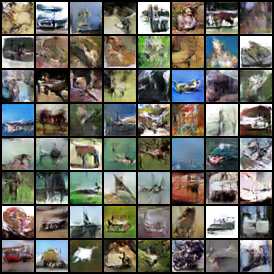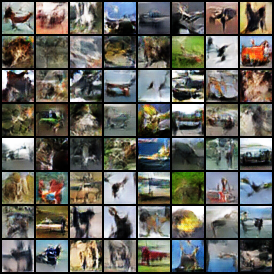参考肖智清老师的《神经网络与PyTorch实战》
import torch.nn as nn
import torch.nn.init as init
import torch
import torch.optim
from torch.utils.data import DataLoader
from torchvision.datasets import CIFAR10
import torchvision.transforms as transforms
from torchvision.utils import save_image
latent_size = 64
n_channel = 3
n_g_feature = 64
gnet = nn.Sequential(
nn.ConvTranspose2d(latent_size, 4 * n_g_feature, kernel_size=4, bias=False),
nn.BatchNorm2d(4 * n_g_feature),
nn.ReLU(),
nn.ConvTranspose2d(4 * n_g_feature, 2 * n_g_feature, kernel_size=4, stride=2, padding=1, bias=False),
nn.BatchNorm2d(2 * n_g_feature),
nn.ReLU(),
nn.ConvTranspose2d(2 * n_g_feature, n_g_feature, kernel_size=4, stride=2, padding=1, bias=False),
nn.BatchNorm2d(n_g_feature),
nn.ReLU(),
nn.ConvTranspose2d(n_g_feature, n_channel, kernel_size=4, stride=2, padding=1),
nn.Sigmoid()
)
n_d_feature = 64
dnet = nn.Sequential(
nn.Conv2d(n_channel, n_d_feature, kernel_size=4, stride=2, padding=1),
nn.LeakyReLU(0.2),
nn.Conv2d(n_d_feature, 2 * n_d_feature, kernel_size=4, stride=2, padding=1, bias=False),
nn.BatchNorm2d(2 * n_d_feature),
nn.LeakyReLU(0.2),
nn.Conv2d(2 * n_d_feature, 4 * n_d_feature, kernel_size=4, stride=2, padding=1, bias=False),
nn.BatchNorm2d(4 * n_d_feature),
nn.LeakyReLU(0.2),
nn.Conv2d(4 * n_d_feature, 1, kernel_size=4)
)
def weights_init(m):
if type(m) in [nn.ConvTranspose2d, nn.Conv2d]:
init.xavier_normal_(m.weight)
elif type(m) == nn.BatchNorm2d:
init.normal_(m.weight, 1.0, 0.02)
init.constant_(m.bias, 0)
gnet.apply(weights_init)
dnet.apply(weights_init)
dataset = CIFAR10(root='./CIFARdata', download=True, transform=transforms.ToTensor())
dataloader = DataLoader(dataset, batch_size=64, shuffle=True)
criterion = nn.BCEWithLogitsLoss()
goptimizer = torch.optim.Adam(gnet.parameters(), lr=0.0002, betas=(0.5, 0.999))
doptimizer = torch.optim.Adam(dnet.parameters(), lr=0.0002, betas=(0.5, 0.999))
batch_size = 64
fixed_noises = torch.randn(batch_size, latent_size, 1, 1)
epoch_num = 15
for epoch in range(epoch_num):
for batch_idx, data in enumerate(dataloader):
real_images, _ = data
batch_size = real_images.size(0)
labels = torch.ones(batch_size)
preds = dnet(real_images)
outputs = preds.reshape(-1)
dloss_real = criterion(outputs, labels)
dmean_real = outputs.sigmoid().mean()
noises = torch.randn(batch_size, latent_size, 1, 1)
fake_images = gnet(noises)
labels = torch.zeros(batch_size)
fake = fake_images.detach()
preds = dnet(fake)
outputs = preds.view(-1)
dloss_fake = criterion(outputs, labels)
dmean_fake = outputs.sigmoid().mean()
dloss = dloss_real + dloss_fake
dnet.zero_grad()
dloss.backward()
doptimizer.step()
labels = torch.ones(batch_size)
preds = dnet(fake_images)
outputs = preds.view(-1)
gloss = criterion(outputs, labels)
gmean_fake = outputs.sigmoid().mean()
gnet.zero_grad()
gloss.backward()
goptimizer.step()
if batch_idx % 100 == 0:
fake = gnet(fixed_noises)
save_image(fake, f'./GAN_saved02/images_epoch{epoch:02d}_batch{batch_idx:03d}.png')
print(f'Epoch index: {epoch}, {epoch_num} epoches in total.')
print(f'Batch index: {batch_idx}, the batch size is {batch_size}.')
print(f'Discriminator loss is: {dloss}, generator loss is: {gloss}', '\n',
f'Discriminator tells real images real ability: {dmean_real}', '\n',
f'Discriminator tells fake images real ability: {dmean_fake:g}/{gmean_fake:g}')
gnet_save_path = 'gnet.pt'
torch.save(gnet, gnet_save_path)
# gnet = torch.load(gnet_save_path)
# gnet.eval()
dnet_save_path = 'dnet.pt'
torch.save(dnet, dnet_save_path)
# dnet = torch.load(dnet_save_path)
# dnet.eval()
for i in range(100):
noises = torch.randn(batch_size, latent_size, 1, 1)
fake_images = gnet(noises)
save_image(fake, f'./test_GAN/{i}.png')
# print(gnet, dnet)
生成图片依然很模糊


保存神经网络参数,可以再写一个小循环生成多张图片:
from torch.utils.data import DataLoader
from torchvision.datasets import CIFAR10
import torchvision.transforms as transforms
from torchvision.utils import save_image
import os
import torch
import torch.optim
dataset = CIFAR10(root='./CIFARdata', download=True, transform=transforms.ToTensor())
dataloader = DataLoader(dataset, batch_size=64, shuffle=True)
for batch_idx, data in enumerate(dataloader):
real_images, _ = data
batch_size = real_images.size(0)
print(f'#{batch_idx} has {batch_size} images.')
if batch_idx % 100 == 0:
path_ = os.path.join(r'I:\save_CIFAR', f'{batch_idx}.png')
save_image(real_images, path_, normalize=True)





















 1124
1124











 被折叠的 条评论
为什么被折叠?
被折叠的 条评论
为什么被折叠?








